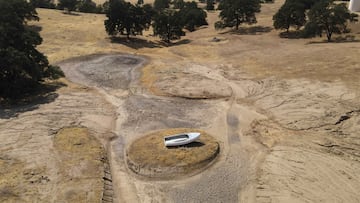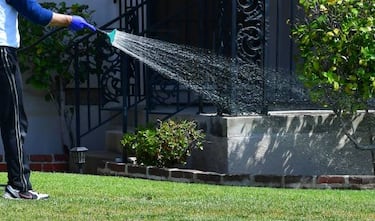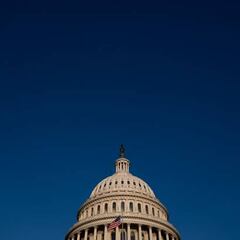Drought in California: measures, restrictions and how long will they last?
California faces another year of water shortages with 40.8% of the state under extreme drought conditions after the second-driest water year on record.

California faces a third year of severe drought conditions due to lack of supply, a dwindling snowpack in the California Sierra and a state-wide failure to meet proposed voluntary reductions in water usage as the western US continues to broil under climate conditions that are shattering records and leading to calls from experts for serious action to be taken immediately to avert a crisis in the near future.
The US Drought Monitor was created in 2000, in time to witness and record the longest period of drought in California in history, which lasted 376 weeks from 27 December, 2011, to 5 March, 2019. However, experts warn that period never really came to an end and California could be in the grip of a megadrought that could last for decades.
Currently, 100% of California is under D0-D1 drought conditions, which are classed as abnormally dry to moderate drought, with 95.2% of the state under severe drought and 40.8% suffering extreme drought conditions. As things stand according to the US Drought Monitor, there are no counties in California under D4 conditions, which signify exceptional drought and, among other measures, involves the rescue and relocation of fish. However, the State of California’s Drought Action monitor shows some patches of D4 conditions and notes that the state has just experienced its driest winter in 100 years, while 2021 was the second-driest water year on record.
D3 drought conditions alone are enough to mean that wildfire season lasts for the entire year and affects parts of the state that are typically considered wet. A fire designated the Calf Canyon fire is currently sweeping through northern New Mexico, the most destructive of nearly two dozen sweeping the parched Southwest and has raised concerns the drought-hit region is in for a long, brutal fire year. With fires concentrated in the Southwest, the area burned by US wildfires year-to-date is up around 30% from the 10-year average and nearly twice the figure at this point in 2021, according to the National Interagency Fire Center.
Droughts are common in California.
— Insider (@thisisinsider) June 5, 2021
But this year's is much hotter and drier than others, evaporating water more quickly from the reservoirs and the sparse Sierra Nevada snowpack that feeds them.https://t.co/5BzRsbeFI5 pic.twitter.com/WHI2AFrQvb
Sierra Nevada snowpack dwindling
The western US has been locked in a drought for several years and 2021 was the worst year on record in the state in the 126 years since records began in California. The state’s snowpack, largely based in the Sierra Nevada mountain range, accounts for around 30% of the state’s water, according to Department of Water Resources figures. As of 1 April, the official end of the “rainy season,” snowpack in the California Sierra was at 38% of its annual average.
“We are not expecting any significant amount of additional precipitation — certainly not something that would make any difference for the drought […] In other words, most of what we’re going to get, we have gotten,” Jeanine Jones, drought manager with the California Department of Water Resources, told The New York Times.

Southern California declares water shortage emergency
Forecasts for the 2022 drought season make for grim reading. On 26 April, Southern California declared a water shortage emergency, enforcing an order for outdoor usage by businesses and citizens (such as for watering, car washing etc) to be limited to one day a week from 1 June. The partial ban represents the first time in history the Metropolitan Water District of Southern California has taken such a step and will affect around six million people in Los Angeles, Ventura and Bernardino counties, which rely heavily on water supplies from Northern California.
“There is not enough supply available to meet the normal demands in these areas for the remainder of the year,” Adel Hagekhalil, the MWD’s general manager, told the Los Angeles Times. “We need serious demand reductions.”
In March, California reduced State Water Project allocations – which carry supplies from the Sacramento-San Joaquin River Delta to around 27 million people and three million acres of farmland in other parts of the state - from 15% to 5%.
“We are experiencing climate change whiplash in real time with extreme swings between wet and dry conditions,” read a statement from Department of Water Resources Director Karla Nemeth. “That means adjusting quickly based on the data and science.”
However, despite State Governor Gavin Newsom asking residents to commit to a voluntary 15% reduction in water usage, figures released last month by state water officials showed that urban Californian residents used 2.6% more water in January 2022 than in the same month in 2020, although there was a statewide decrease of 6.5% from July 2021 to January 2022 over the same period a year earlier.
California’s ecosystems are vitally important to the state’s water supply, agriculture, wildlife, and economy - yet many of these #ecosystems are in dire health. Smarter permitting could help. #CAwater https://t.co/BgYuhAD0td
— PPIC Water (@PPICWater) April 27, 2022
What does the future hold for Californian water supplies?
Newsom has so far resisted calls to implement water rationing in California, relying instead on the voluntary reduction scheme, but the immediate future of the state’s water supply hangs in the balance. Jay Famiglietti, director of the Global Institute for Water Security at the University of Saskatchewan and formerly Senior Water Scientist at NASA Jet Propulsion Laboratory, wrote an LA Times op-ed in 2015 warning that California had only one year of water reserves stored in its reservoirs. While the ravages of climate change do little to foster optimism that mother nature will intervene to avert a crisis, The Pacific Institute High Efficiency scenario, first posited in 2005, shows that water use in 2030 could be 20 percent below 2000 levels. Los Angeles is investing heavily in water storage, rainwater capture and reclamation with the goal of supplying 70% of the city’s water from local sources by 2035.
Related stories
The Public Policy Institute of California has also praised two initiatives – the Safe and Affordable Drinking Water Fund and the 2014 Sustainable Groundwater Management Act– the latter of which requires local water administration agencies to adopt sustainability plans for high- and medium-priority groundwater basins and achieve sustainability of these basins within 20 years of implementation.
“If we are worried about this year, we are really playing the short game,” Doug Parker, the director of the California Institute for Water Resources, told The Guardian in June, 2021. “It’s next year that I think is more important. When you get into three, four, five years in a row of drought – that’s when things really start to get serious. We all wish we knew what was going to happen next winter.”

